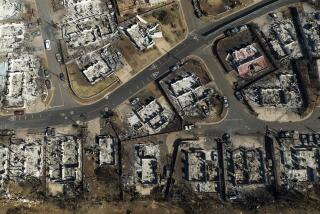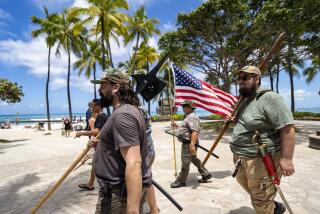Shared Grief Can’t Mask Lingering Pain
KANEOHE, Hawaii ‚ÄĒ The deaths of 27 Hawaii-based troops last week in a helicopter crash in Iraq united many Hawaiians in grief. Almost in unison, U.S. flags throughout the islands were lowered to half-staff, churches held memorial services, politicians and pundits spoke of the state as a grieving family.
But for William Aila, a native Hawaiian, and untold others here, the tragedy evoked more complicated emotions.
‚ÄúSorrow, yes, for the soldiers and their families, and the way it happened,‚ÄĚ said Aila, referring to Wednesday‚Äôs helicopter crash near Rutbah, Iraq, which killed 30 Marines and one sailor. But the shared grief, he said, didn‚Äôt put to rest a century of conflict and mistrust between the U.S. military and many local residents. For some, the animosity traces back to 1893, when U.S. Marines helped overthrow the Hawaiian monarchy.
It has been a tense, fitful coexistence ever since.
Conflicts have arisen over weapons testing, pollution, crime and indigenous land claims. Some have involved moral and political differences.
A majority of Hawaiians, according to local polls, oppose the war in Iraq while sharing a geographically small space with large numbers of military personnel, many of whom have been or will be deployed to the Middle East or Afghanistan. As often happens in militarized zones, civilians sometimes become loyal to individual soldiers and their families even while remaining aloof to the military organization.
Hawaii has a higher percentage of the population connected to the armed forces than any other state. Between 50,000 and 80,000 soldiers and dependents live here, the majority of them on Oahu, an island 40 miles long and 33 miles wide. It’s also home to most of the state’s civilian population.
The military controls about a quarter of Oahu’s land and operates more than 100 installations, including tiny ridge-top radar stations and Pearl Harbor, the country’s largest naval command center. The soldiers killed Wednesday were based on or near the sprawling Marine Corps Base at Kaneohe Bay, on the island’s windward side.
Along this eastern shore, young men with buzz cuts, many in uniform with wives and children in tow, are seen in the shopping malls and streets, mingling easily with other islanders.
In towns such as Kailua and Kaneohe, the military is intricately woven into the fabric of the communities. Soldiers and spouses attend church and belong to community clubs, and their children attend local nonmilitary schools. One military program assigns soldier-volunteers to work in the public school system.
‚ÄúThere isn‚Äôt a town that doesn‚Äôt have a military presence nearby,‚ÄĚ said Michael Pavkovic, a history professor at Hawaii Pacific University. Pavkovic is director of the school‚Äôs diplomacy and military studies program. ‚ÄúYou leave the house, and right away there‚Äôs a base, so you interact with the people, you see them everyday at the grocery store, and you feel it more when you lose them.‚ÄĚ
On Sunday, dozens of people entered the Marine base to pay tribute to its 27 fallen troops. Many placed flowers and wreaths at the Pacific War Memorial just inside the base’s front gate. A memorial service for the Hawaii-based sailor who died will be held at Pearl Harbor on Thursday. The Marine Corps will hold a service for the 26 Marines from the Hawaii base in early March.
Pavkovic said tensions between military and civilian groups had eased some over the last two decades, primarily because the armed services pump so much money into an increasingly vulnerable local economy. The military complex here adds about $3 billion to the economy annually, second only to tourism.
But Pavkovic acknowledged that tension still existed, and that conflicts would continue. ‚ÄúThere are always going to be groups unhappy,‚ÄĚ he said.
Aila belongs to such a group. He is 46, a harbormaster for the state, and a descendant of native Hawaiians who were forcibly evicted from the Makua Valley, in western Oahu, during World War II. About 20 farming families were affected. The military took the valley to use as a training ground and promised to return it six months after the war ended.
‚ÄúHere we are, 60 years later, and we‚Äôre still waiting,‚ÄĚ Aila said.
The military eventually bought out most of the landowners, but some resisted. The descendants of some of the holdouts belong to a group called Hui Malama O Makua, or the Group for the Protection of Makua. The group continues the fight to reclaim the valley, but meanwhile has protested the military’s use of the land as a training ground, where troops fire ammunition and detonate explosives.
The military stopped its live-fire training for three years beginning in 1998 because of a lawsuit, but renewed the training after the Sept. 11 terrorism attacks.
Native Hawaiian groups are engaged in at least six land-claims or environmental conflicts with the military, some that date to the turn of the last century.
Anthropologists believe Polynesians first occupied the islands 1,500 years ago and set up a string of chiefdoms. The dynasty of King Kalakaua reigned until the overthrow of the kingdom in a coup d’etat orchestrated by American plantation owners with the help of U.S. Marines who aimed their guns on the royal family’s residence.
President Clinton, in 1993, signed a resolution apologizing to native Hawaiians for the U.S. military’s role in the overthrow.
Today, native Hawaiians account for 6.6% of the 1.3 million people who live on the islands, but 22% of residents, or roughly 250,000 people, claim some Hawaiian ancestry.
‚ÄúThere‚Äôs a certain amount of acceptance that they [military people] are here and we have to live with them,‚ÄĚ Aila said. ‚ÄúBut a lot of us are angry with the way the military has conducted itself. It‚Äôs the arrogance of believing they can take whatever they want, they can do whatever they want.‚ÄĚ
Not all protest comes from native groups.
Antiwar and environmental advocates decry pollution of the state’s forests and waters by the military.
Kyle Kajihiro, head of the Hawaii chapter of the American Friends Service Committee, a peace and social justice organization founded by the Quakers, said the U.S. Department of Defense had identified more than 820 military contamination sites in Hawaii, most of them in Pearl Harbor.
‚ÄúThere are signs that say, ‚ÄėNo Swimming, No Fishing,‚Äô but a lot of people do it for subsistence,‚ÄĚ Kajihiro said. ‚ÄúThis is a health issue that‚Äôs looming.‚ÄĚ
Because of the heightened state of alert on the islands, soldiers have been given orders not to talk to the media. Instead, reporters are directed to speak with public information officers, who describe the military’s good-faith efforts to be responsive to community needs.
In Kailua, at the Aikahi Park Shopping Center near the back entrance of the Marine Corps base, soldiers and family members talked about their lives in Hawaii. Some gave their names; others would not.
Keri Escobedo, 30, whose husband is a staff sergeant, said she had never felt as unwelcome by a local population as she had here. She and her husband have been stationed in California, Texas, Pennsylvania, New Jersey and Japan. Escobedo said military people were generally treated well in towns next to a large base, but that ‚Äúthe farther out you go, the worse it gets.‚ÄĚ
She said Marines who went off base were routinely harassed, and often beaten, by locals. ‚ÄúWe‚Äôre just not wanted here,‚ÄĚ Escobedo said. ‚ÄúI can‚Äôt wait to leave.‚ÄĚ
One sergeant, who didn’t want to be named, described a recent incident in which he and several Marine buddies were asked by local men to leave a popular surfing beach on the North Shore.
‚ÄúThey said this was their beach,‚ÄĚ the sergeant said. Because of the Marines‚Äô buzz cuts, he said, ‚Äúit‚Äôs easy for them to pick us out of a crowd.‚ÄĚ
Capt. Ernest P. Petzrick, an oceanographer with the Navy, said as long as he stayed out of certain areas, he felt safe in Hawaii.
Petzrick said he understood some of the resentment.
‚ÄúAnytime you have a large military establishment, it‚Äôs going to happen,‚ÄĚ he said. ‚ÄúHey, we have a big impact here. We recognize that.‚ÄĚ
More to Read
Sign up for Essential California
The most important California stories and recommendations in your inbox every morning.
You may occasionally receive promotional content from the Los Angeles Times.










